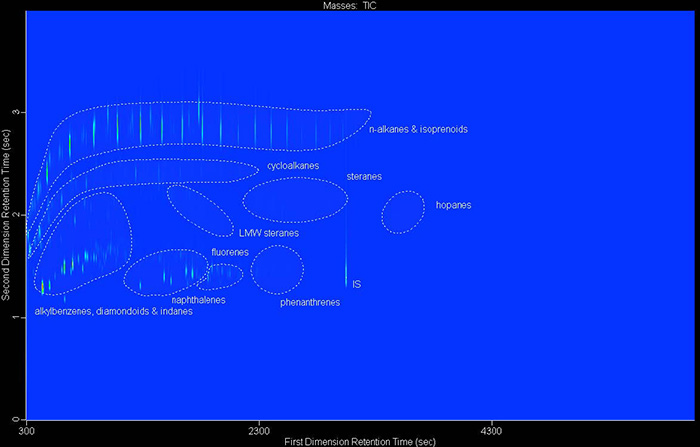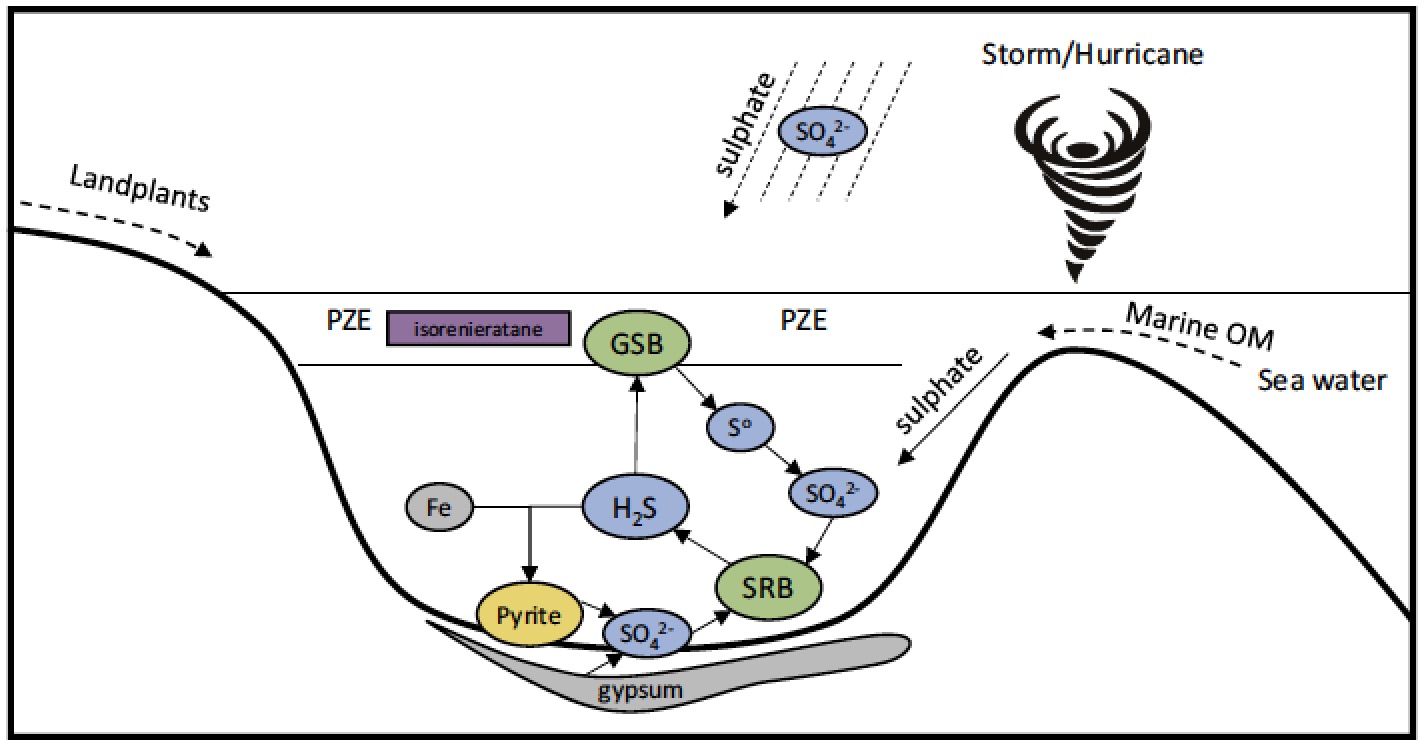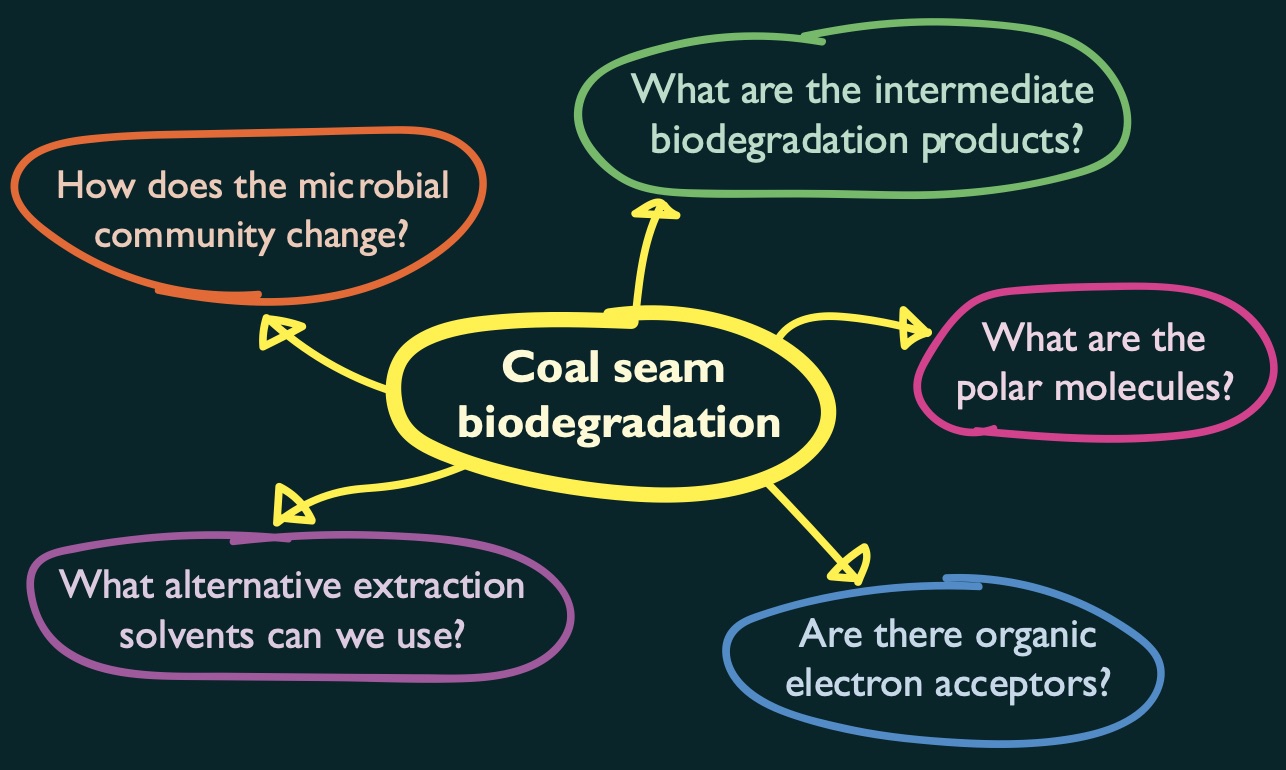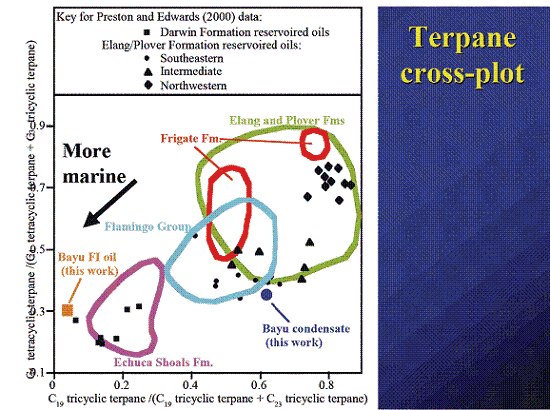Petroleum Geochemistry
He hasFor nearly 15 years until 2006 Simon George worked as a petroleum geochemist at CSIRO. He has continuing interests in this area, especially in the accumulation and fate of oil in reservoirs, and the behaviour of gas in coal seams. Several of the students in the organic geochemistry group are doing related projects. This group of projects are often collaborative with colleagues at CSIRO Energy.
Deconvolution of the UCM
Petroleum biodegradation is the alteration of crude oil by living organisms. It is an essential hydrocarbon oxidation process for recycling nutrients in the biosphere. For in-situ anaerobic petroleum biodegradation to happen properly, conditions are required which support microbial life like sufficient access to petroleum, and the availability of other nutrients. The Gippsland Basin, located on the south-eastern coast of Australia, is one of Australia’s premier oil provinces, and many of the fields in the basin show strong evidence of in-situ crude oil biodegradation. A prominent hallmark of biodegradation is an increase in the ‘unresolved complex mixture’ (UCM) component of the oil, which is too complex to be resolved by traditional capillary gas chromatography. Because the constituents of UCMs are not GC amendable and hence unknown, this repository of geochemical information cannot be accessed with conventional GC methods. Gas chromatograms of saturated and unsaturated hydrocarbons extracted from crude oil samples from the basin contain UCMs of different extent related to the intensity and retention time of the compounds comprising the mixtures. Comprehensive two-dimensional gas chromatography time-of-flight mass spectrometry (GC×GCToF- MS) has an increased resolution, and therefore the potential to separate thousands of previously unidentified compounds.

GCxGC-ToF-MS of sample Bream 3 (whole oil) in TIC mode including compound classifications, with non-polar to polar separation.
Use of oil inclusions to define early oil generations
Petroleum-bearing fluid inclusions are small encapsulations of oil and gas that offer an invaluable opportunity to better constrain the evolution of petroleum systems. Insights into palaeo fluid compositions complement observations on present day fluid compositions, which represent only the end-point of complex cumulative processes throughout basin history. The abundance, distribution and composition of oil inclusions can be used to provide clearer data on the extent of palaeo-oil columns, and the composition of that palaeo-oil.
For example, analysis of the FI oil confirms a more marine-influenced source facies of the palaeo-oil, with the Echuca Shoals Formation being the most likely source based on oil-oil and oil-source correlations. The FI oil appears to represent a marine source end-member.
George, S. C., Lisk, M., and Eadington, P. J. (2004) Fluid inclusion evidence for an early, marine-sourced oil charge prior to gas-condensate migration, Bayu-1, Timor Sea, Australia. Marine and Petroleum Geology 21, 1107-1128.
Simon George has published many papers on this topic, and the work continues in various forms, including with collaborators in China.
Recent papers involving fluid inclusions:
Volk, H. and George, S.C. (in review) Using petroleum inclusions to trace petroleum systems – a review. Organic Geochemistry.
Ping, H., Chen, H., Zhai, P., Zhu, J., George, S.C. (accepted November 2017) Petroleum charge history in the Baiyun depression and Panyu lower uplift in the Pearl River Mouth Basin, northern South China Sea: Constraints from integration of organic geochemical and fluid inclusion data. AAPG Bulletin
Li, K., George, S.C., Cai, C., Gong, S., Sestak, S., Armand, S., Zhang, X. (2019) Fluid inclusion and stable isotopic studies of thermochemical sulfate reduction: Upper Permian and Lower Triassic gasfields, northeast Sichuan Basin, China. Geochimica et Cosmochimica Acta 246, 86-108.
Ping, H., Chen, H., George, S.C., Li, C., Hu, S. (2019) Relationship between the fluorescence color of oil inclusions and thermal maturity in the Dongying Depression, Bohai Bay Basin, China: Part 1. Fluorescence evolution of oil in the context of hydrous pyrolysis experiments with increasing maturity. Marine and Petroleum Geology 100, 1-19.
Ping, H., Chen, H., Zhu, J., George, S.C., Mi, L., Pang, X., Zhai, P. (2018) Origin, source, mixing and thermal maturity of natural gases in the Panyu Lower Uplift and the Baiyun depression, Pearl River Mouth Basin, northern South China Sea. AAPG Bulletin 102, 2171-2200.
Ping, H., Chen, H, Thiéry, R. and George, S.C. (2017) Effects of oil cracking on fluorescence color, homogenization temperature and trapping pressure reconstruction of oil inclusions from deeply buried reservoirs in the northern Dongying Depression, Bohai Bay Basin, China. Marine and Petroleum Geology 80, 538-562.
Lacustrine and terrigenous source rocks
We are working on lacustrine and terrigenous source rocks in Australia (Gippsland Basin) and China (Dongying Depression; Chaoyang Basin; Songliao Basin; and several others).

A schematic illustration of the sulfur cycle and the organic inputs in the Dongying Depression, Bohai Bay Basin. OM = organic matter, GSB = green sulfur bacteria, SRB = sulfate-reducing bacteria, PZE = photic zone euxinia.
Recent papers:
Xu, H., George, S.C., Hou, D. (2019) Algal-derived polycyclic aromatic hydrocarbons in Paleogene lacustrine sediments from the Dongying Depression, Bohai Bay Basin, China. Marine and Petroleum Geology 102, 402-425.
Xu, H., George, S.C., Hou, D. (2019) The occurrence of isorenieratane, 2α-methylhopanes, crocetane, 24-n-propylcholestanes and 24-norcholestanes in Paleogene lacustrine source rocks from the Dongying Depression, Bohai Bay Basin: Implications for bacterial sulphate reduction, photic zone euxinia and seawater incursions. Organic Geochemistry 127, 59-80.
Jiang, L. and George, S.C. (2018) Biomarker signatures of Upper Cretaceous Latrobe Group hydrocarbon source rocks, Gippsland Basin, Australia: Distribution and palaeoenvironment significance of aliphatic hydrocarbons. International Journal of Coal Geology 196, 29-42.
Jiang, L., George, S.C. and Zhang, M. (2018) The occurrence and distribution of rearranged hopanes in crude oils from the Lishu Depression, Songliao Basin. Organic Geochemistry 115, 205-219.
Shale Gas and Coal Bed Methane
Coal seam gas (CSG) consists primarily of methane and carbon dioxide, which are generated via thermogenic and/or biogenic processes. Thermogenically, CSG is produced from the cracking of complex hydrocarbons under increasing pressure and temperature, and biogenically, as the end-product of microbial metabolic pathways. The mechanisms of in situ biodegradation of organic compounds in coal are not yet well understood. More labile and reactive compounds likely include low molecular weight n-alkane and aromatic hydrocarbons. This study aims to identify and understand geochemical and microbial community changes that occur during the biogenic conversion of coal to methane.

Projects/students:
Huiyuan Xu: Source rock development and organic matter inputs in the Dongying Depression of the Bohai Bay Basin, and oil-source correlation in the East China Sea Basin, China (writing up PhD)
Lian Jiang: Investigation of biomarkers in coal seams of the Gippsland Basin, offshore Australia
Bronwyn Campbell: Geochemical characteristics of coal seam biodegradation (joint project with CSIRO and Mol. Sci.)
Wenjing Ding: Geochemical characteristics of Chinese lacustrine oils
Li Li: Organic Matter Accumulation Mechanisms in the Lower Cretaceous Jiufotang Formation, Chaoyang Basin, NE China

